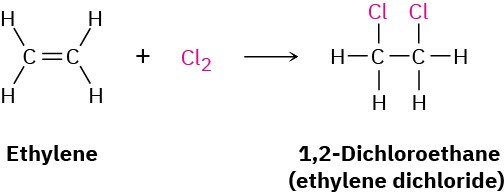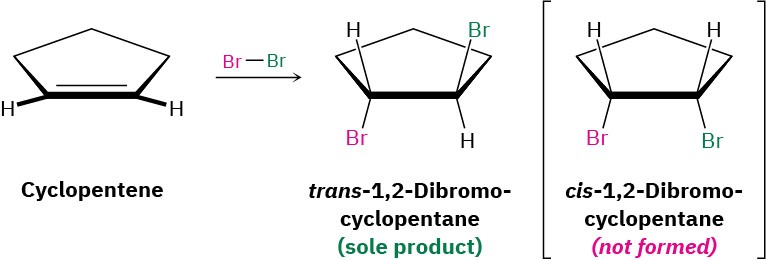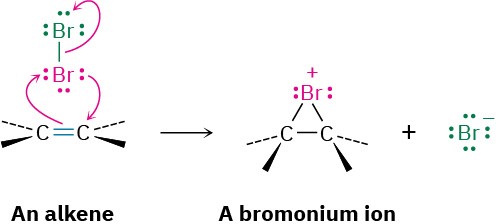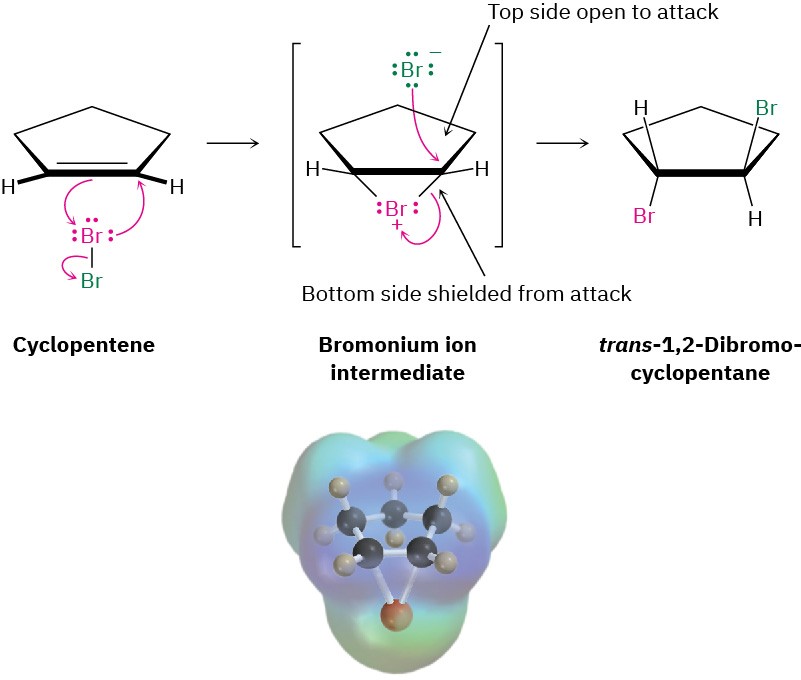5.4 Halogenation of Alkenes: Addition of X2
Bromine and chlorine add rapidly to alkenes to yield 1,2-dihalides, a process called halogenation. For example, nearly 50 million tons of 1,2-dichloroethane (ethylene dichloride) are synthesized worldwide each year, much of it by addition of Cl2 to ethylene. The product is used both as a solvent and as starting material for the manufacture of poly(vinyl chloride), PVC, the third most widely synthesized polymer in the world afterpolyethelyne and polypropolyne. Fluorine is too reactive and difficult to control for most laboratory applications, and iodine does not react with most alkenes.
 Based on what we’ve seen thus far, a possible mechanism for the reaction of bromine with alkenes might involve electrophilic addition of Br+ to the alkene, giving a carbocation intermediate that could undergo further reaction with Br– to yield the dibromo addition product.
Based on what we’ve seen thus far, a possible mechanism for the reaction of bromine with alkenes might involve electrophilic addition of Br+ to the alkene, giving a carbocation intermediate that could undergo further reaction with Br– to yield the dibromo addition product.
 Although this mechanism seems plausible, it’s not fully consistent with known facts. In particular, it doesn’t explain the stereochemistry of the addition reaction. That is, the mechanism doesn’t account for which product stereoisomer is formed.
Although this mechanism seems plausible, it’s not fully consistent with known facts. In particular, it doesn’t explain the stereochemistry of the addition reaction. That is, the mechanism doesn’t account for which product stereoisomer is formed.
When the halogenation reaction is carried out on a cycloalkene, such as cyclopentene, only the trans stereoisomer of the dihalide addition product is formed, rather than the mixture of cis and trans isomers that might have been expected if a planar carbocation intermediate were involved. We say that the reaction occurs with anti stereochemistry, meaning that the two bromine atoms come from opposite faces of the double bond—one from the top face and one from the bottom face.
 An explanation for the observed stereochemistry of addition was suggested in 1937 by George Kimball and Irving Roberts, who proposed that the reaction intermediate is not a carbocation but is instead a bromonium ion, R2Br+, formed by electrophilic addition of Br+ to the alkene. (Similarly, a chloronium ion contains a positively charged, divalent chlorine, R2Cl+.) The bromonium ion is formed in a single step by interaction of the alkene with Br2 and the simultaneous loss of Br−.
An explanation for the observed stereochemistry of addition was suggested in 1937 by George Kimball and Irving Roberts, who proposed that the reaction intermediate is not a carbocation but is instead a bromonium ion, R2Br+, formed by electrophilic addition of Br+ to the alkene. (Similarly, a chloronium ion contains a positively charged, divalent chlorine, R2Cl+.) The bromonium ion is formed in a single step by interaction of the alkene with Br2 and the simultaneous loss of Br−.
 How does the formation of a bromonium ion account for the observed anti stereochemistry of addition to cyclopentene? If a bromonium ion is formed as an intermediate, we can imagine that the large bromine atom might “shield” one side of the molecule. Reaction with Br– ion in the second step could then occur only from the opposite, unshielded side to give the trans product.
How does the formation of a bromonium ion account for the observed anti stereochemistry of addition to cyclopentene? If a bromonium ion is formed as an intermediate, we can imagine that the large bromine atom might “shield” one side of the molecule. Reaction with Br– ion in the second step could then occur only from the opposite, unshielded side to give the trans product.
 Alkene halogenation reactions occur in nature just as they do in the laboratory but are limited primarily to marine organisms living in halide-rich environments. These biological halogenation reactions are carried out by enzymes called haloperoxidases, which use H2O2 to oxidize Br− or Cl− ions to a biological equivalent of Br+ or Cl+. Electrophilic addition to the double bond of a substrate molecule then yields a bromonium or chloronium ion intermediate just as in the laboratory, and reaction with another halide ion completes the process. Halomon, for example, an antitumor pentahalide isolated from red alga, is thought to arise by a route that involves twofold addition of BrCl through the corresponding bromonium ions.
Alkene halogenation reactions occur in nature just as they do in the laboratory but are limited primarily to marine organisms living in halide-rich environments. These biological halogenation reactions are carried out by enzymes called haloperoxidases, which use H2O2 to oxidize Br− or Cl− ions to a biological equivalent of Br+ or Cl+. Electrophilic addition to the double bond of a substrate molecule then yields a bromonium or chloronium ion intermediate just as in the laboratory, and reaction with another halide ion completes the process. Halomon, for example, an antitumor pentahalide isolated from red alga, is thought to arise by a route that involves twofold addition of BrCl through the corresponding bromonium ions.
 Problem 5.4
Problem 5.4
What product would you expect to obtain from addition of Cl2 to 1,2-dimethylcyclohexene? Show the stereochemistry of the product.
Problem 5.5
Addition of HCl to 1,2-dimethylcyclohexene yields a mixture of two products. Show the stereochemistry of each, and explain why a mixture is formed.

